
• SUBSCRIBE •MAGZTER •NEWSLETTER
•CONTAC T US


Asia's leading yachting lifestyle media
More results...
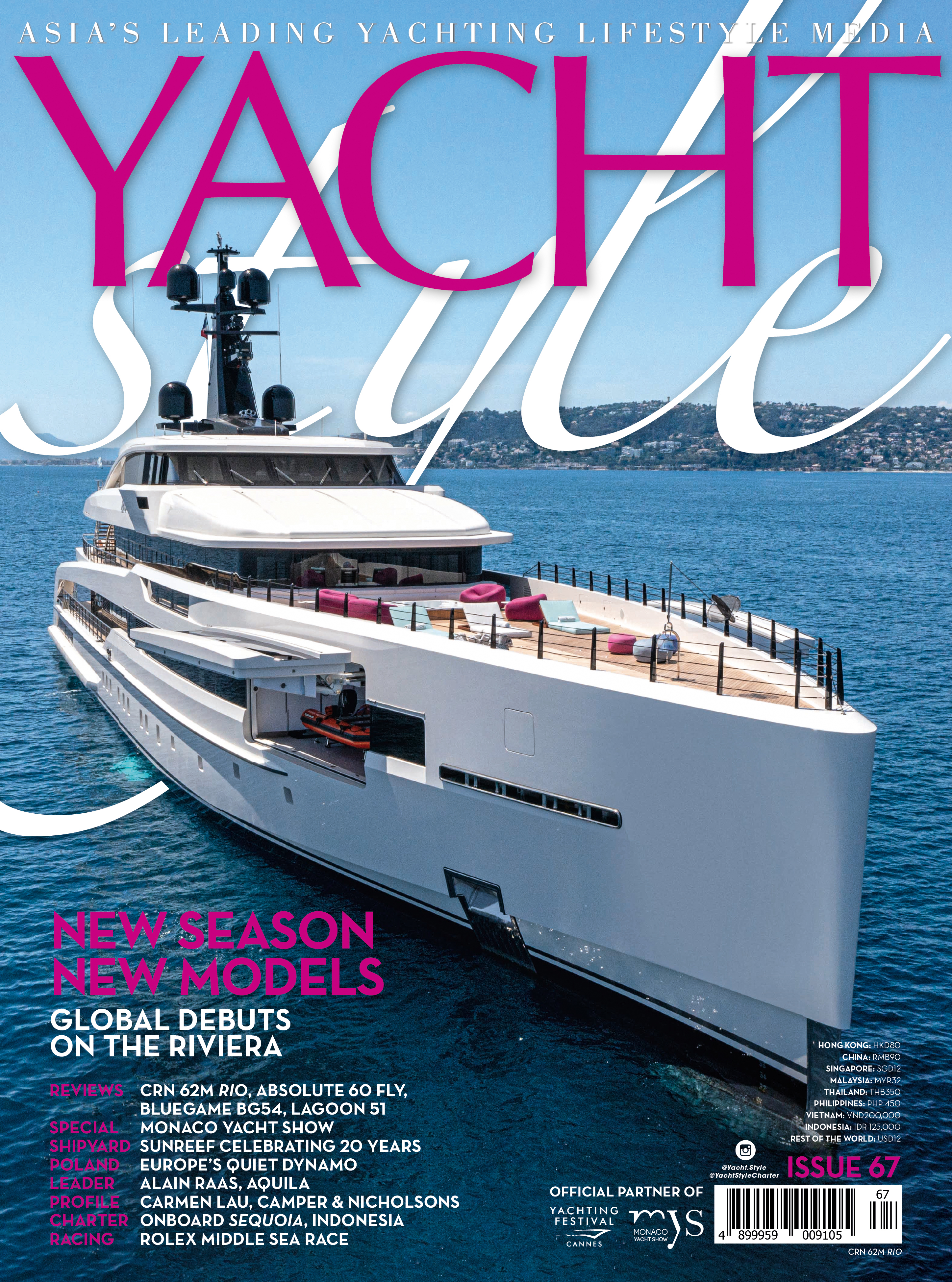
First Silent 60 showcases Silent-Yachts’ optional kite sail system
- November 29, 2021
Based in Mallorca, the first Silent 60 is the first of the brand’s solar-electric catamarans to be fitted with the optional kite sail system, which has been ordered on many more hulls.

Silent-Yachts has showcased its first Silent 60, which carries 42 solar panels for 17kWp of solar energy and is further boosted by the brand’s optional kite sail system.
Succeeding the 64 and 55 models, the Silent 60 is the first of the builder’s new generation of yachts that also include the 62 3-Deck, 80, 80 3-Deck and 100, with each 3-Deck offering a much larger flybridge that can be fully open or partially enclosed.
Silent-Yachts produce ocean-going yachts that are fully powered by solar energy and can cruise with zero emissions for up to 100nm a day. The Silent 60 is designed by Pattaya-based Dr Albert Nazarov and units are being built by nearby PMG Shipyard in Rayong (read more) and Silent’s own shipyard in Italy.

Built in Thailand and now based in Mallorca, hull one has twin 250kW e-motors, a 100kW generator and 210kWh battery storage. However, the Silent 60 has a wide range of power options including two electric motors up to 340kW each and battery storage up to 286kWh.
KITE SAIL OPTION A 9sqm or 13sqm kite sail can be fitted on any Silent-Yachts model and is housed in a storage locker under the foredeck along with an electric winch and a short, collapsible mast.

On the first unit, the mast is connected by four shrouds to pad eyes on deck that distribute the forces through the hull structure. However, on subsequent deliveries – eight units with the kite wing option have been ordered to date – the mast will be mounted on a baseplate inside the locker to leave the foredeck clutter-free.
After inflating the kite, it’s released overboard to drift away on the surface of the water. Pulling on the lines launches it into the air and once it reaches the optimal flight height, it begins to trace a figure ‘8’ in the sky and generates power to pull the yacht.

To stop kiting, the automated app controls move the kite to a position above the boat where it has the least pull on the line. From here it can be winched down electrically and collapsed over the foredeck ready for stowage.
PULL NOT PUSH Michael Köhler, founder and CEO of Silent-Yachts (read more), said: “The main advantages of a kite over a conventional sail system are that it does not throw shade on the solar panels, does not need a tall mast and generates up to 10 times more power per square metre than a traditional sail. At 5 Beaufort, we can drive with the kite indefinitely at 6-7 knots, which is faster than a comparable sailing catamaran in such wind conditions when crossing the ocean, for example.

“In addition to that, it saves about 1.5 tons of weight compared to a conventional rig and costs much less. It makes even more sense for the Silent boats that run on renewable solar energy because the power generated by a kite easily exceeds the energy consumption of the system, so you can charge the batteries while cruising under kite power. And besides that, it’s great fun!”
The builder says a big advantage of a kite compared to a conventional sail is that the kite flies in much higher altitudes and therefore gets more steady, stronger winds, yet can be used at low wind speeds of less than 10 knots.
POWER STEERING As the kite pulls the boat rather than pushes it like a conventional sail, it requires good steering capability, especially as a motor yacht typically has a small rudder and big propellers, contrary to a sailing boat. However, this problem can be solved by running the solar-powered motors at 100rpm, while a conventionally powered boat would need to run diesel motors when using a kite.

Silent-Yachts Captain Mike Wandler said he had tested the performance of a 9sqm kite on different headings and at wind angles of up to 40 degrees. “Unlike a conventional sailing boat, the best results were directly downwind. Under kite power with no engines on or propellers turning, the boat speed was between 4-5 knots,” Wandler said.
“We then switched on the electric motors, drawing just 1kW each, to reduce drag from the propellers and improve the flow of water over the rudders for better steering. This led to boat speeds from 6-7 knots over the same headings, a significant improvement on our original predictions.”

The first Silent 60 has four guest cabins on the lower deck including a spacious full-beam master suite forward, although other layout solutions are available. The saloon has up to 2.3m of headroom, while other social areas include the aft cockpit, flybridge and the foredeck.
A sub-1m draft allows access to shallow bays, ideal for cruising grounds in the Caribbean and Southeast Asia. The lifting hydraulic platform can carry a 4m tender, while the swim platforms on each side can be extended on an owner’s request to be able to carry a pair of electric jet-skis.

Featuring a new, high-performance hull form with a longer waterline and reverse bow, the Silent 60 has a cruising speed of 6-8 knots, but can reach 20 knots depending on the power options. www.silent-yachts.com www.farfallamarinegroup.com
Silent-Yachts sells first flagship 100 Explorer Silent-Yachts has sold the first unit of its new flagship – the Silent 100 Explorer solar-electric catamaran designed by Marco Casali.
Editor's Picks

Yacht insurance is money well spent

Sunreef’s 60 Power Eco

Powercat players are multiplying
EDITOR'S PICKS

Introducing Azimut’s triple yacht showcase at Monaco Yacht Show

Saxdor and Fraser team up at Monaco Yacht Show

B-Craft luxury water-sports dream boat at Monaco Yacht Show

Benetti wows Monaco crowds with three superyachts

Camper & Nicholsons showcases all-star fleet at Monaco Yacht Show 2024

Debut for wallywind110 at Monaco Yacht Show 2024

Indonesia-Italy connections with Yacht Sourcing and Rizzardi

Northrop & Johnson brings wide line-up to Monaco

Subscribe To Our Newsletter
Copyright © 2024 Website by Malikhan Design & Digital
All Rights Reserved © 2023

Copyright © 2024 Yacht Style.All Rights Reserved .Website by Unstoppable.
Discover more from Yacht Style
Subscribe now to keep reading and get access to the full archive.
Type your email…
Continue reading
Electric boats
Silent yachts, silent yachts launches solar catamaran with kite wing sail and 100 mile daily range from the sun.
Solar boat engineer and designer Silent Yachts has shared new details of the SILENT-60, a 60′ catamaran with 42 solar panels and two electric propelled motors backed by 286 kWh of battery capacity. While Silent Yachts’ solar-powered vessels are all unique, the SILENT-60 will also be fitted with a 9-13 square meter kite wing, generating additional clean power to pull the yacht.
Silent Yachts was founded by Heike and Michael Köhle, who together have sailed over 75,000 nautical miles around the world, and decided there had to be a better way to propel yachts with clean energy.
After beginning research into solar yacht technologies in 2004, Silent Yachts gathered five years of sailing data and constructed its first fully self-sufficient solar-powered catamaran , the Solarwave 46.
After a five-year trial at sea that began in 2010, Silent Yachts had a proven solar yacht concept, and began serial production of luxury sustainable vessels in 2016 with the SILENT-64. By 2018, The SILENT-64 had become the first serial-production solar-powered bluewater catamaran to cross the Atlantic, from Cartagena, Spain to Barbados in 16 days.
In 2020, the company announced a partnership with Volkswagen Group , which will supply all the components and batteries for a new 50-foot yacht. The yacht will be designed with the help of Cupra, and will utilize VW’s MEB Platform.
Earlier this year, Silent Yachts launched the SILENT-60 as a more powerful, revamped generation of the SILENT-64. With the company’s latest announcement, the SILENT-60 catamaran looks to separate itself from other solar yachts by utilizing even more sustainable propulsion techniques.
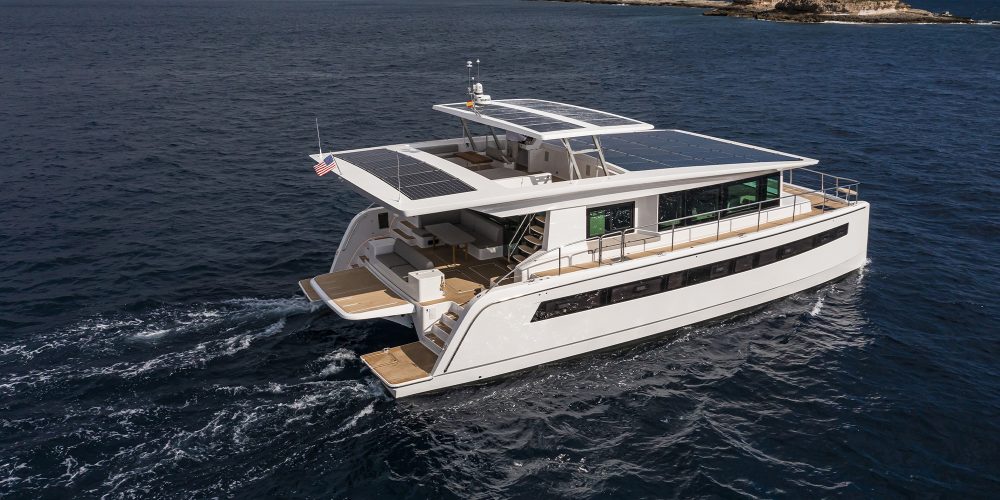
The SILENT-60 solar yacht specs
In addition to being a yacht completely powered using solar energy, Silent Yachts has now shared an additional kite wing option that can deliver even more clean range to the Silent-60.
According to the press release, the SILENT-60 will be the first vessel to be fitted with a nine or 13 square meter kite wing, although the option will now be available on all Silent Yacht models.
After deploying the compact kite, it drifts away on the surface of the water before pulling taught and launching into the air. When it reaches its optimal flight height, the kite begins to trace a “figure 8” in the sky, generating additional power to pull the solar yacht. Silent Yacht founder Michael Köhler elaborates:
The main advantages of a kite over a conventional sail system are that it does not throw shade on the solar panels, does not need a tall mast, and generates up to 10 times more power per square meter than a traditional sail. In addition to that it saves about 1.5 tons of weight compared to conventional rig and costs much less. It makes even more sense for the SILENT boats that run on renewable solar energy because the power generated by a kite easily exceeds the energy consumption of the system, so you can charge the batteries while cruising under kite power. And besides that, it’s great fun!
When yacht owners want to stop kiting, an automated app controls the kite, moving it to a position right above the boat where it has the least pull on the line. This allows for more easy electric winching down over the foredeck for stowage.

In addition to the wind kite option, the SILENT-60 yacht comes with 42 solar panels, garnering 17 kWp of energy from the sun to power two, 340 kW electric motors. The system is backed by a battery capacity up to 286 kWh.
As a required safety measure, the SILENT-60 is equipped with a generator and 1,000 liters of fuel. However, according to the Silent-Yachts’ owners, they almost never use it because they have enough solar power and electric energy.
According to Silent Yachts, the SILENT-60 can cruise efficiently with zero emissions using solar power only for up to 100 nautical miles a day and can maintain that pace for weeks. The vessel’s cruise speed is six to eight knots, but it can get up to a top speed of 20 knots using the all-electric motors.
The SILENT-60 comes with four guest cabins but can be designed with a custom layout for those willing to pay a bit more. Speaking of which, the SILENT-60 starts at 2.39 million euros ($2.69 million).
The first of these SILENT-60 solar yachts was built in Thailand, but the company plans to build future units in Italy. Furthermore, Silent Yachts has already shared design plans for a SILENT-80 and SILENT-100 Explorer vessel.
More electrified boats are sure to make their maiden voyage soon. In the meantime, check out this launch video detailing the style and luxury of the SILENT-60:
Electrek’s take
The more I see electric propulsion on larger and larger boats, the more excited I get. While this is still such a niche segment in not just maritime transportation, but electrified mobility overall, it really excites me personally.
Many of you (hopefully) saw my previous article where I got to captain a solar-powered yacht called the Ramblin’ Rose, thanks to Sunwater Marine . That experience helped me learn and experience a lot of similar technology that Silent Yachts has implemented on an even larger and more powerful scale with its catamarans.
While it’s safe to say that my current income level might get me on board a SILENT-60 solar yacht as a mere stowaway, those who can afford their own are going to be blessed with luxury and performance with zero emissions. The quicker we stop burning diesel in our Earth’s waters (and anywhere else while we’re at it), the better.
A top speed 20 knots is nearly 23 mph, not bad for two electric motors getting all their energy from the sun. Obviously, that speed is not sustainable for the batteries, but being able to get 100 NMs from the sun each day truly means you can take this yacht out for weeks at a time if you want. Not to mention the unique wing kite that actually pulls the 60-foot yacht, unlike a sailboat that is pushed by the wind. No range anxiety here.
I’d love to get below deck on one of the Silent Yachts and explore the inner workings… while getting a tan in the Mediterranean, perhaps? A kid could dream, right? For now, I’ll simply have to report electric boat news from my squeaky chair, pretending the cars whizzing by outside are calm ocean waves lapping against the yacht’s hull. Is it too early for a mojito?
FTC: We use income earning auto affiliate links. More.


Scooter Doll is a writer, designer and tech enthusiast born in Chicago and based on the West Coast. When he’s not offering the latest tech how tos or insights, he’s probably watching Chicago sports. Please send any tips or suggestions, or dog photos to him at [email protected]

Manage push notifications


Silent 60, The Solar Electric Catamaran With a Kite Sail System

The new SILENT 60 solar powered catamaran carries 42 solar panels for 17 kWp of solar energy to power two electric motors of up to 2x340kw. Backed up by a battery capacity of up to 286 kWh, the yacht can cruise efficiently with zero emissions solely on solar power for up to 100 nautical miles a day for weeks.
To further improve its green credentials and range, for longer crossings the first SILENT 60 is also fitted with a compact 9 or 13-sqm kite wing. The kite wing is optionally available on all SILENT models.
How the kite wing works
A dedicated storage locker under the foredeck houses the kite wing and all its components, including an electric winch and a short, collapsible mast. On the first unit the mast is connected by four shrouds to pad eyes on deck that distribute the forces through the hull structure, but on subsequent deliveries (8 units with the kite wing option have been ordered to date) the mast will be mounted on a baseplate inside the locker to leave the foredeck clutter-free.
After inflating the kite, it is released overboard to drift away on the surface of the water. Pulling on the lines launches it into the air and once it reaches the optimal flight height, it begins to trace a figure “8” in the sky and generates power to pull the yacht.
If you want to stop kiting, the automated app controls move the kite to a position right above the boat where it has the least pull on the line. From here it can be winched down electrically and collapsed over the foredeck ready for stowage.

“The main advantages of a kite over a conventional sail system are that it does not throw shade on the solar panels, does not need a tall mast, and generates up to 10 times more power per square metre than a traditional sail. In addition to that it saves about 1,5 tons of weight compared to conventional rigg and costs much less,” says Michael Köhler . “It makes even more sense for the SILENT boats that run on renewable solar energy because the power generated by a kite easily exceeds the energy consumption of the system, so you can charge the batteries while cruising under kite power. And besides that, it’s great fun!”
“We tested the performance on different headings and at wind angles of up to 40 degrees with the 9-sqm kite,” says SILENT-YACHTS’ Captain Mike Wandler . “Unlike a conventional sailing boat, the best results were directly downwind. Under kite power with no engines on or propellers turning, the boat speed was between 4 and 5 knots. We then switched on the electric motors drawing just 1kW each to reduce drag from the propellers and improve the flow of water over the rudders for better steering, this led to boat speeds from 6 to 7 knots over the same headings – a significant improvement on our original predictions.”
A big advantage of a kite compared to a conventional sail is, that the kite flies in much higher altitudes and therefore gets more steady and stronger winds up there. Therefore, it can already be used at low wind speeds of less than 10 knots, when it would not make any sense to hoist a sail on a sailing boat of comparable size.

As the kite rather pulls the boat than pushes it like a conventional sail, it requires good steering capabilities, which are compromised by the fact, that on a motorboat the rudder is typically pretty small and the propeller big. On a sailing boat it is the opposite. For this reason, it is difficult to steer a motorboat that is being pulled by a kite, but by turning on the motors, and by letting them run at a low speeds of 100 rpm this problem can be solved.
But only on a SILENT Yacht it is possible to run the electric motors at such a low rpm powered solely by solar energy and without consuming fossil energy. Any conventionally powered boat would need to run the diesel motors permanently when using the kite.
“At 5 Beaufort we can drive with the kite indefinitely at 6-7 knots, which is faster than a comparable sailing catamaran in such wind condition when crossing the ocean, for example,” adds Michael Kohler .
Different layouts availabls
The first SILENT 60 has four guest cabins on the lower deck, including a spacious master suite, but other layout solutions are available. There are numerous social areas on board, including an airy main salon, an aft cockpit, a cosy bow area and a flybridge. The yacht also has high headroom throughout (up to 2.32m in the main salon).
Thanks to a draft of under 1m the yacht can access shallow bays, a crucial consideration for cruising grounds in the Caribbean and South East Asia. Two swimming platforms in the stern can be extended on owner’s request to carry a pair of electric jet skis. The lifting hydraulic platform between the two platforms can carry a 4 m tender.

Efficient technology
The SILENT 60 is equipped with the company’s ventilation system, which provides cool and fresh air to all the interior guest spaces and can be individually adjusted to suit conditions. In addition, a reverse-cycle heat-pump system cools and heats the interior for all-season comfort. The insulated hull ensures that stable on-board temperatures can be achieved without excessive energy consumption.
A watermaker powered by solar-energy produces enough water to supply a full complement of guests. All on board appliances operate on the 220/110-volt system. The galley has good refrigerator and freezer space and an efficient induction cooker that precludes the need for carrying propane gas.
Beneteau Introduces the New First 30… the Planing Cruiser
Grand soleil 52 performance: new life to the myth, nautor swan merges with sanlorenzo group, royal huisman project 410, ready to roll the hull, live your passion, subscribe to our mailing list.
672 Wine Club
- Motorcycles
- Car of the Month
- Destinations
- Men’s Fashion
- Watch Collector
- Art & Collectibles
- Vacation Homes
- Celebrity Homes
- New Construction
- Home Design
- Electronics
- Fine Dining
- Benchmark Wines
- Brian Fox Art
- Disneyland Resort
- Ka La’I Wakiki Beach
- Kalamazoo Grill
- Raffles Hotels & Resorts
- Tributary Idaho
- Sports & Leisure
- Health & Wellness
- Best of the Best
- The Ultimate Gift Guide
This Innovative New Solar-Powered Catamaran Uses a Giant Kite for Even More Speed
The new appendage allows the boat to travel up to 5 knots faster., rachel cormack.
Digital Editor
Rachel Cormack's Most Recent Stories
This new 111-foot hybrid catamaran is topped with a glass hot tub, heesen’s new 204-foot custom superyacht will be one of its largest yet.
- This 18th-Century Diamond Necklace Was Worn at Two British Coronations. Now It Could Fetch $2.8 Million.
- Share This Article
It looks like kites are taking off in the marine industry. Silent Yachts , whose solar -powered fleet continues to grow apace , has just unveiled a new catamaran that uses a giant kite to generate even more power and speed.
The solar-electric vessel is one of eight Silent 60 hulls currently under construction at the yard’s Thailand production facility, but it’s the first one to feature the new technology. Silent says the kite wing allows the 30-ton cat to travel up to 5 knots faster, giving it a maximum speed of 20 knots.
Related Stories
- Lexus Is Cooking Up a New 600 HP Coupe With an Old-School Stick Shift
- This New Half-Size Bugatti Might Just Make Your Full-Size Car Jealous
- This New Catamaran Concept Was Designed to Carry Your Bugatti Across the High Seas
Designed by Wingit , the light and compact kite fuses seamlessly with the vessel. Unlike a traditional sail, it doesn’t require a big mast and therefore is far easier to operate. According to Silent, it’s more powerful, too, with the ability to generate up to 10 times more grunt per square foot than conventional sails.

The kite can climb more than 393 feet above the vessel. Silent Yachts
The kite, which spans just shy of 140 square feet, attaches to a small 2-foot mast via four Kevlar ropes. For launch, it first gets inflated by an electric pump before it’s thrown overboard to drift away with the wind. While in the air, the automatic steering can take over and the kite can climb more than 393 feet above the vessel to increase propulsion. To retrieve the kite, the owner or crew uses the electric winch to pull it above the front deck. When not in use, the kite wing and its components can be stored in the bow, out of sight.
Aside from added speed, the kite reduces the amount of energy required from the e-motors and thus extends the vessel’s range: It can cruise for up to 100 miles a day for weeks on end. The kite also serves as backup propulsion should a floating fishing line get tangled in the propellers, for instance.
“The kite system sounds like the perfect match for windy days together with the electric propulsion system of Silent Yachts,” the German owner said in a statement. “I am an enthusiast of new technologies which help, little by little, to overcome the ecological challenges we are facing today.”

The vessel can cruise for up to 100 miles a day for weeks on end. Silent Yachts
In addition to the kite-sail system, the 60-footer sports a high-performance hull with a long waterline, reverse bow and low draft for added efficiency. It also packs an array of green tech for silent and sustainable cruising sans any emissions. The 42 rooftop solar panels send kilowatts to banks of lithium batteries that in turn power the e-motors and the onboard amenities.
Onboard, the spacious interior features an airy main saloon and four guest cabins on the lower deck. Elsewhere, the bow and flybridge offer space for alfresco lounging while the bridge deck can hold water toys, stand-up paddle boards, kayaks and even e-bikes. The catamaran also features a liftable hydraulic platform located between two swim platforms aft that can store a pair of electric Jet Skis or a large tender.

The catamaran features a liftable hydraulic platform located between two swim platforms. Silent Yachts
“The Silent 60 is the first example of a new generation of solar electric catamarans that we produce and many more will follow,” the company’s CEO Michael Köhler added.
Indeed, the yard has received 17 orders for the Silent 60 to date and is offering the new kite-sail system for all its models.
It’s not the only kite-powered yacht concept that’s been floated in the industry, either. Last year, Red Yacht Design and Dykstra Naval Architects unveiled a 211-foot superyacht fitted with a giant kite to help propel it through the ocean.
Rachel Cormack is a digital editor at Robb Report. She cut her teeth writing for HuffPost, Concrete Playground, and several other online publications in Australia, before moving to New York at the…
Read More On:
- Silent Yachts
More Marine

Forget Diesel. The World’s Largest Sportfishing Yacht Will Run on Vegetable Oil.

A Frothy Genoa International Boat Show Proves the Yachting World Is Alive and Kicking

Meet the Wine Club That Thinks Differently.
Receive editor-curated reds from boutique California producers four times a year.
Give the Gift of Luxury
Latest Galleries in Marine

Sunreef Ultima 111 in Photos

Monte-Carlo Superyacht in Photos
More from our brands, rare diamond neglige necklace linked to marie antoinette’s downfall and french revolution comes to sotheby’s auction, celtics’ jaylen brown launches shoe brand after nike spat, ‘it’s bisan from gaza and i’m still alive’ wins news & doc emmy despite calls for its disqualification; big winners include cnn, abc, nat geo, simone leigh, jeff koons, and other top artists offer work for kamala harris fundraiser, the best yoga mats for any practice, according to instructors.
the new SILENT 60 electric catamaran features a kite wing and 42 solar panels
Zero emission cruising at 20 knots.
SILENT-YACHTS unveils the new SILENT 60, a solar-powered catamaran with a kite wing instead of conventional sails. 42 solar panels generate 17 kWp to power two electric motors of 200 kW each. the 60ft (18m) yacht is also backed up by a battery capacity of 286 kWh, allowing zero emission cruising for up to 100 nautical miles per day.
THE KITE WING
the kite wing and its components—including an electric winch and a short, collapsible mast—are stored in a locker under the foredeck. on the first SILENT 60 unit, the mast is connected by four shrouds to pad eyes on deck that distributes the forces through the hull structure, but on subsequent units, the mast will be mounted on a baseplate inside the locker to leave the foredeck clutter-free.
after inflating the kite, it is released overboard to drift away on the surface of the water. pulling on the lines launches it into the air and once it reaches the optimal flight height, it begins to trace a figure ‘8’ in the sky and generate power to pull the yacht. reversing the process brings the kite down. the automated app controls move the kite to a position right above the boat where it has the least pull on the line. from here it can easily be winched down and collapsed over the foredeck ready for stowage. the kite wing is now available on all SILENT-YACHTS models.
flexible layout
the first SILENT 60 has four guest cabins on the lower deck, including a spacious master suite, but other layout solutions are available. there are numerous social areas onboard, including an airy main salon, an aft cockpit, a cozy bow area and a flybridge. the yacht also has high headroom throughout (up to 2.3m in the main salon).
thanks to a draft of under 1m the yacht can access shallow bays, a crucial consideration for cruising grounds in the caribbean and south east asia. two swimming platforms in the stern can be extended on the owner’s request to carry a pair of electric jet skis. the lifting hydraulic platform between the two platforms can also be enlarged to carry a 4m tender.
efficient technology & OCEANIC RANGE
the SILENT 60 is equipped with the company ’s aeration system, which provides cool and fresh air to all the interior guest spaces and can be individually adjusted to suit conditions. in addition, a reverse-cycle heat-pump system heats the interior for all-season comfort. the insulated hull ensures that stable onboard temperatures can be achieved without excessive energy consumption.
a watermaker powered by the solar-electric system produces enough water to supply a full complement of guests. all on-board appliances operate on the 220/110-volt system. the galley has good refrigerator and freezer space and an efficient induction cooker that precludes the need for carrying propane gas.
the SILENT 60 is designed to go everywhere as a true bluewater cruising yacht. the solar-electric system is configured to power all on the onboard systems without the need of a fossil-fueled generator. featuring a new, high-performance hull form with a longer waterline and reverse bow, the yacht has a cruising speed of 6-8 knots, but can reach 20 knots if needed.
project info:
name: SILENT 60 company: SILENT-YACHTS
designboom has received this project from our DIY submissions feature, where we welcome our readers to submit their own work for publication. see more project submissions from our readers here.
edited by: lynne myers | designboom
dbinstagram (2250)
Solar power (380), watercraft (77).
functional UFO jet boat zooms through water as a motorized flying saucer for lakes or rivers
yacht design (236)
Product library.
a diverse digital database that acts as a valuable guide in gaining insight and information about a product directly from the manufacturer, and serves as a rich reference point in developing a project or scheme.
- car design (843)
- design interviews (62)
- carbon fiber (121)
- ora ito (23)
- RENAULT (57)
- barbie (39)
- smartphone design (235)
- luca trazzi (10)
- monterey car week 2024 (9)
- porsche (109)

- AMERICA'S CUP
- CLASSIFIEDS
- NEWSLETTERS
- SUBMIT NEWS

New breed: first Silent 60 solar electric catamaran with kite wing launched
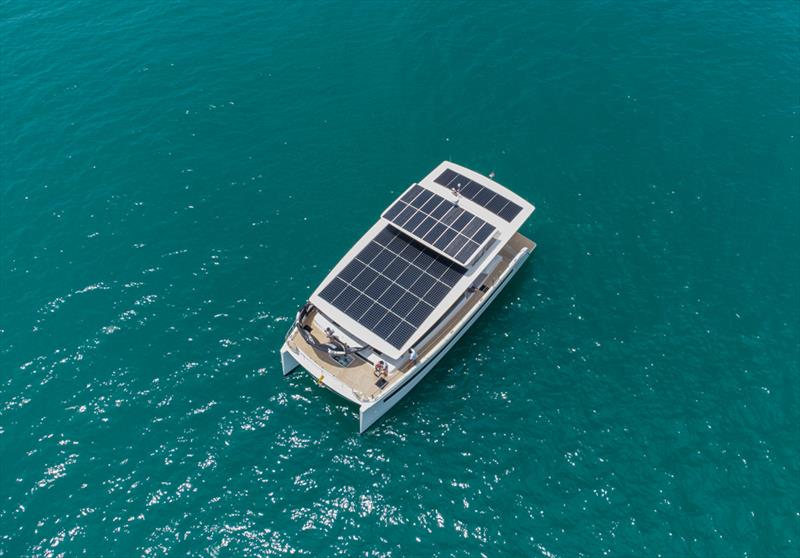
Related Articles
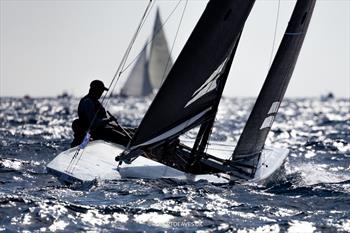
- Yachting World
- Digital Edition

Review: Silent 55, the extraordinary solar powered yacht
- January 18, 2019
Silent Yachts is tapping into the solar zeitgeist and creating a new meaning for the term ‘powercat’. Sam Fortescue reports

There is a slow, silent revolution under way in the yachting world. It is a revolution that is introducing tonnes of lithium and a sprinkling of silicon to the spec list of new boats. Holding out the promise of silent mobility, plus limitless domestic power on board, it made a big splash at the last Cannes Festival of Yachting – not least thanks to the new Silent 55 catamaran which debuted there.
From the pontoon side, the Silent 55 looks like a typical modern catamaran, with a big coachroof studded with windows and a flybridge helm. Except there’s no mast. Now, bear with me here. I realise that this is a sailing magazine, but we will shortly get back to more familiar territory. The unique qualities of this catamaran only become apparent from up top, where an expanse of solar panels stretches away fore and aft, embedded into the coachroof. The hard top itself carries yet more panels, and can be folded down flush to give an unshaded solar array of 49m2. During the heat of a summer day in the Med, this is capable of generating 10kW of power and up to around 60kWh in the course of the day.

But to make a solar system work in reality, Köhler had to go back to the drawing board on yacht design. The saloon and hulls have extra thermal insulation to keep air-con losses down, and the use of carbon and aramid in key areas helps reduce the overall weight to a decent 17 tonnes (a Lagoon 52 weighs 22.5 tonnes). He has tried to keep windows out of the direct sun with long overhangs and in contrast to the Lagoon’s 12 deck hatches, the Silent 55 has just two.
Holistic design
On the other hand, it has lots of opening windows, to allow a natural draught to do its job. “It’s a holistic approach – you can’t take the batteries and the drivetrain and drop it into another boat.”
Of course, using the propulsion system quickly takes its toll of the boat’s 140kW battery bank. The model on display at Cannes had two 135kW motors, giving you just half an hour of silent motoring flat-out, albeit at a top speed of over 20 knots. More reasonable 30kW engines and a single-digit speed give you greater range. Nonetheless, the electric drive alone isn’t going to allow you to outrun a storm, or race home after a day at anchor, so the boat is designed to work with a generator hidden in the heavily insulated transom of its starboard hull. At cruising speed of around 5-6 knots, Köhler says there is rarely any need to use the generator, citing an owner who has just emailed him triumphantly about a second year totally generator-free. “In the end, you have to compare it to the performance of a sailing boat,” Köhler says. “It is as fast as a sailing boat in similar conditions – after all, there is no wind without sun.” He went so far as to tell me during the sea trial in Palma, Mallorca, that he believed the majority of sailors would happily dispense with the hassle of sails and a rig if only they could enjoy silent motoring and anchoring. “As soon as people realise the incredible concept of this boat, they won’t understand why they ever did anything else.”
The market does not seem to agree with him – yet. Sales of the boat have been good – they have already sold six, five of which are already in the water. But of those, four customers have taken the sail option, which means planting a 19.7m tall mast complete with boom and rigging slap bang in the middle of the coachroof solar array. “I was a bit amazed,” Köhler admits. “The shade from the rig reduces the energy generated by the solar area, while it costs more and is heavier, so consumes more fuel. Maybe it is for optical reasons.” In fact, the shade of the rig slashes the average yield of the solar panels in half. In the Med, that means around 30kWh per day. But perhaps it figures. The typical profile of buyers is an environmentalist who has a Tesla electric car and is “an early adopter who likes to have things before others”. And at low speeds, with modest use of the air-con, the reduced energy generation should still cover daily consumption.

The performance under sail should be reasonable because of the lightweight build of the boat, its broad 8.47m beam and stub keels added to each hull. Control lines are led back via conduits in the coachroof to the flybridge helm station, to make single-handing under sail a possibility.
More interesting, I think, is a sort of halfway-house option using a kite rig. This optimises the performance of the solar panels and gives plenty of propulsion. On the smaller 55 and the 64, Silent Yachts currently recommends a 19m2 kite that costs around €25,000 – a fraction of the cost of a new mast, boom, shrouds and sails. “The sail automatically makes a figure of eight above the boat, and you can steer it with a joystick or an app on an android phone,” Köhler explains. “It can propel the 55 at up to 6 knots, even in light winds.” Perfect for an Atlantic crossing, then.
For the bigger Silent 79, which will hit the water in the summer, a commercial grade Sky Sail system needs to be used – a smaller version of the ones used on cargo ships. This kite can propel the boat at ten knots, but it costs more than ten times as much as its smaller cousin. Both are capable of pulling the boat upwind. So far, so new. But outside the novel energy and propulsion system, the Silent 55 aims to do what many other cruising catamarans are trying to achieve. “Most of our clients order for circumnavigation and long-term cruising,” Köhler says. So the boat is aimed to be as comfortable and capable as possible with watermakers, TVs and an induction hob that all capitalise on the boat’s abundant energy. A flexible configuration allows owners the choice of between three and six cabins – the latter designed for charter. The owner’s cabin lies forward of the saloon, under the windows of the coachroof, which provide magnificent views and abundant natural light. There’s a walk-around bed and steps down into the starboard hull give access to an en-suite shower room and heads.

In my view, the best cabin lies aft of this, accessed in the traditional manner down steps out of the saloon. The king-sized bed lies athwartships and the shower is larger than that of the master cabin. There’s more space down here, better headroom and still plenty of light courtesy of the many hull lights.

When I had the chance to sea trial the Silent 55, albeit in motorboat format, I jumped at it. It was a contrary autumn day on Mallorca with 15 knots breeze – just a shame, then, that this wasn’t one of the sailing configured versions.
To start with, getting on board is made really easy courtesy of deep boarding platforms on the skirts. She feels rather square because of that vast, glazed saloon with its deep overhang, and perhaps because of the utilitarian nature of the hard top, which is really about supporting more solar panels. Nevertheless, the side decks are broad and uncluttered. The space up top is designed to concertina down flat, hence the hydraulic rams, fold-down seat back and lowering console. It makes a great sailing position, though, with all round visibility, and is also perfect for sundowners at anchor. When the rain comes down, this feels quite exposed, but there is a fully sheltered helm at the front of the saloon, and it is also possible to drive the boat from anywhere using a tablet thanks to smart electronics. Under power, the handling is superb. The quietness of the motors is astonishing, and I gather they’ll be inaudible on the next boat, which will do away with the gearbox. Even in the aft cabins, directly above the motors, there is no more than a distant hum. The boat responds instantly to the power and the wind seemed to have no impact at all. As with any propulsion system, the power consumption jumps as you pile on the speed – it was sobering to see. At 6 knots, both motors drew 10kW but at 8 knots it was closer to 30kW. I liked the huge saloon with its raised table for 360º views. And the sliding door and window gives great access aft, connecting the saloon and cockpit in fine conditions. The finish was smart and in muted tones, feeling more Scandinavian than German.
Intriguingly, at least it seems to me, Köhler has tapped into something with the concept behind Silent Yachts – but not entirely for the reasons that he expected. Buyers are opting for the sail or kite versions of the boat because they want a comfortable wind-powered craft with abundant, quiet energy on tap. It brings a whole new meaning to the term ‘powercat’

Multihulls: new yacht reviews
Yes, the racing world is stretching the boundaries, with 100ft foiling maxi trimarans tearing around the globe and F50s, the…

Multihulls: owners’ experiences and reviews
They have two different boats, different sailing plans and two very different sets of experience. But what these cruisers have…
ACTIVE STORM TRACKER Hurricane and Tropical Storm Information Learn more

Service Locator
- Angler Endorsement
- Boat Towing Coverage
- Mechanical Breakdown
- Insurance Requirements in Mexico
- Agreed Hull Value
- Actual Cash Value
- Liability Only
- Insurance Payment Options
- Claims Information
- Towing Service Agreement
- Membership Plans
- Boat Show Tickets
- BoatUS Boats For Sale
- Membership Payment Options
- Consumer Affairs
- Boat Documentation Requirements
- Installation Instructions
- Shipping & Handling Information
- Contact Boat Lettering
- End User Agreement
- Frequently Asked Questions
- Vessel Documentation
- BoatUS Foundation
- Government Affairs
- Powercruisers
- Buying & Selling Advice
- Maintenance
- Tow Vehicles
- Make & Create
- Makeovers & Refitting
- Accessories
- Electronics
- Skills, Tips, Tools
- Spring Preparation
- Winterization
- Boaters’ Rights
- Environment & Clean Water
- Boat Safety
- Navigational Hazards
- Personal Safety
- Batteries & Onboard Power
- Motors, Engines, Propulsion
- Books & Movies
- Cockpit Confessions
- Communication & Etiquette
- Contests & Sweepstakes
- Colleges & Tech Schools
- Food, Drink, Entertainment
- New To Boating
- Travel & Destinations
- Watersports
- Anchors & Anchoring
- Boat Handling
- ← Lifestyle
SILENT 60: Electric Cat Unfolds Her 'Wings'
Advertisement
Luxury solar-powered catamaran builder adds wind to its oceangoing, ecofriendly cruising arsenal with a custom kite sail system.

Photo: Silent Yachts/Alberto Cocchi
After introducing the first oceangoing production yachts in the world fully powered by solar energy in 2018, Austrian builder Silent-Yachts has added a kite sail system that can add up to 5 knots of speed.
The new SILENT 60 carries 42 solar panels for 17 kWp of solar energy that produce zero-emission cruising for up to 100 nautical miles per day solely on solar power. The SILENT 60 is also fitted with a compact 9-square-meter (97 square feet), or 13-square-meter (140 square feet) kite wing.
"The main advantages of a kite over a conventional sail system are that it does not throw shade on the solar panels, does not need a tall mast, and generates up to 10 times more power per square meter than a traditional sail," says Michael Köhler, the founder and CEO of Silent-Yachts. "It makes even more sense for the SILENT boats that run on renewable solar energy because the power generated by a kite easily exceeds the energy consumption of the system, so you can charge the batteries while cruising under kite power. And besides that, it's great fun!"
Sure, it's base price is about $2.6 million, but 'tis the season for dreaming, so take a look at kite power in action .
After inflating the kite, it is released overboard to drift away on the surface of the water. Pulling on the lines launches it into the air and once it reaches the optimal flight height, it begins to trace a figure eight in the sky and generates power to pull the yacht.
If you want to stop kiting, the automated app controls move the kite to a position right above the boat where it has the least pull on the line. From here it can be winched down electrically and collapsed over the foredeck ready for stowage.
"We tested the performance on different headings and at wind angles of up to 40 degrees with the 9-square-meter kite," says Silent-Yachts' technical controller (aka captain of Hull No. 1) Mike Wandler. "Unlike a conventional sailing boat, the best results were directly downwind. Under kite power with no engines on or propellers turning, the boat speed was between 4 and 5 knots. We then switched on the electric motors drawing just 1kW each to reduce drag from the propellers and improve the flow of water over the rudders for better steering, this led to boat speeds from 6 to 7 knots over the same headings — a significant improvement on our original predictions."

The SILENT 60 has four guest cabins on the lower deck, including a spacious master suite. There are numerous social areas on board, including a main saloon, aft cockpit, cozy bow area, and a flybridge.
Another big advantage of a kite compared to a conventional sail is that the kite flies in much higher altitudes and therefore gets more steady and stronger winds up there. Therefore, it can already be used at low wind speeds of less than 10 knots when it would not make any sense to hoist a sail on a sailing boat of comparable size.
"At 5 Beaufort [17–21 knots] we can drive with the kite indefinitely at 6-7 knots, which is faster than a comparable sailing catamaran in such wind condition when crossing the ocean, for example," adds Kohler.
Related Articles
The truth about ceramic coatings for boats.
Our editor investigates the marketing claims of consumer-grade ceramic coatings.
Fine-Tune Your Side Scan Fishfinder
Take your side-scanning fishfinder off auto mode, and you’ll be spotting your prey from afar in no time
DIY Boat Foam Decking
Closed-cell foam flooring helps make boating more comfortable. Here’s how to install it on your vessel
Click to explore related articles
Rich Armstrong
Senior Editor, BoatUS Magazine
A journalist by training, BoatUS Magazine Senior Editor Rich Armstrong has worked in TV news, and at several newspapers, then spent 18 years as a top editor at other boating publications. He’s built a stellar reputation in the marine industry as one of the most thorough reporters in our business. At BoatUS Magazine, Rich handles everything from boat and product innovation and late-breaking news, to compelling feature stories, boat reviews, and features on people and places. The New Jersey shore and lakes of lower New York defined Rich's childhood. But when he bought a 21-foot Four Winns deck boat and introduced his young family to the Connecticut River, his love for the world of boats flourished from there.
BoatUS Magazine Is A Benefit Of BoatUS Membership
Membership Benefits Include:
Subscription to the print version of BoatUS Magazine
4% back on purchases from West Marine stores or online at WestMarine.com
Discounts on fuel, transient slips, repairs and more at over 1,200 businesses
Deals on cruises, charters, car rentals, hotel stays and more…
All for only $25/year!
We use cookies to enhance your visit to our website and to improve your experience. By continuing to use our website, you’re agreeing to our cookie policy.
- Yachts for sale
- Yachts for charter
- Brokerage News
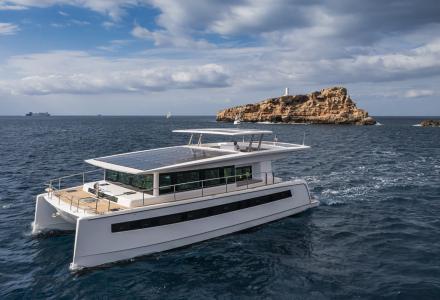
- A Closer Look at Solar Powered Catamaran Silent 60 With a Kite Sail System
- Yacht Harbour
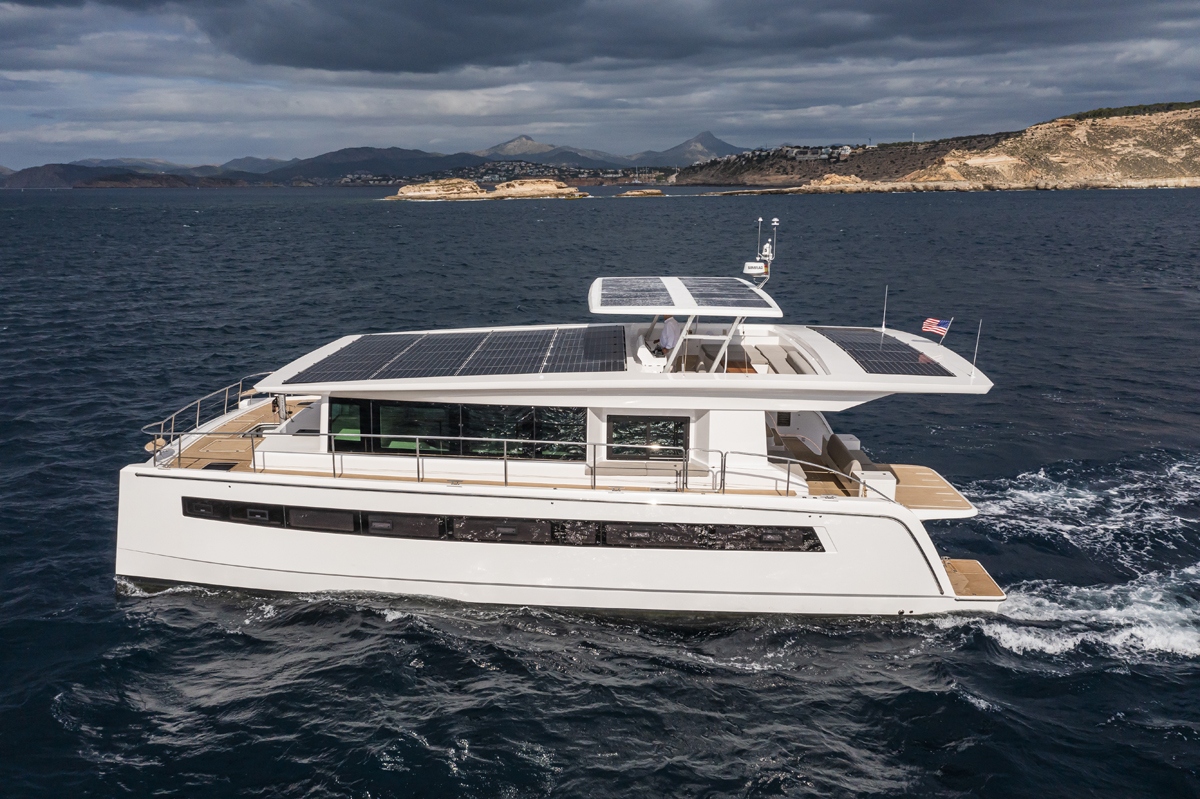
Latest News
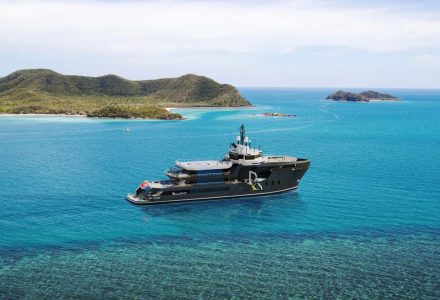

International luxury lifestyle magazine for affluent audience.Since 2009
- Cigars & Spirits
- Real Estate
- Watches|Jewelry
- Sport & Health
- Best Of Luxury
Three major advantages of the kite wing for the yacht
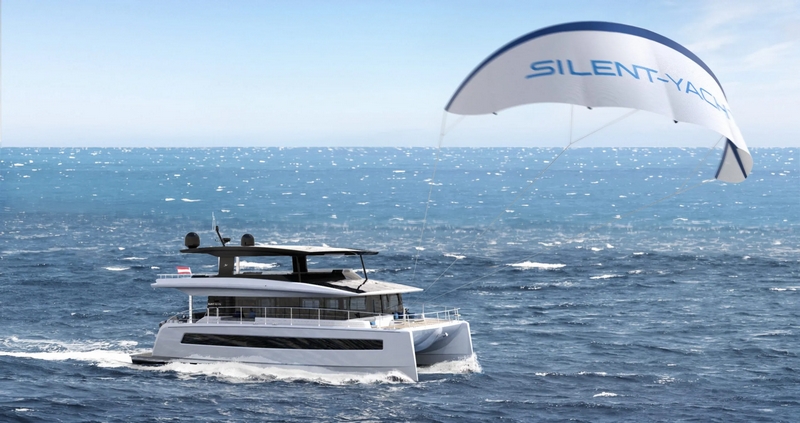
Silent Yachts Silent 60; @Silent Yachts
This innovative kite wing is easy to use and adds up to 5 knots to the Silent-Yacht solar electric catamaran speed.
Silent-Yachts has increased its fleet of innovative oceangoing solar electric catamarans introducing the new Silent 60 that has been launched recently at Silent Yachts production facility in Thailand, which is led by the Swiss entrepreneur Philippe Guénat. This is the first unit of the model while eight more hulls are currently under construction and 17 are ordered in total.
What makes it even greener is that it was built with a kite wing, a special system that in contrast to conventional sailing yachts, does not require a big mast and the kite sail generates much more power per square meter than a conventional sail. Silent Yachts offers the optional available kite-sail system for all their models.
“The kite system sounds like the perfect match for windy days together with the electric propulsion system of Silent Yachts,” said the German owner of the first SILENT 60. “I am an enthusiast of new technologies which help, little by little, to overcome the ecological challenges we are facing today.”
Greener than before
The SILENT 60 carries a light compact kite wing from Wingit, that does not require a big mast to hoist the kite and it´s also easy to use. A kite wing that operates in such heights, generates up to 10 times more power per square meter than a conventional sail.
So, how the kite wing system works? There is a dedicated box in the bow area of the SILENT 60, which contains the kite (the sail is 13 sq. m) including all its components (winches, mast, ropes, etc). Here the entire system is also stored, when not in use.
To launch the kite, it’s only required to set up a small mast, which is only two feet high, with four stays (6 mm Kevlar “ropes”) that need to be fixed to four foldable pad-eyes (this takes a few seconds). After taking out the kite, it gets pumped up with an electric pump that is in the box as well (this takes only a few seconds), you switch on the winch, throw the kite overboard where it will drift away with the wind and then the kite can start from the water by pulling the ropes. When in the air, the automatic steering can take over – the pulling rope is released until the kite is more than 120 meters above the boat and it starts to paint a huge “8” in the sky.
Bringing it down is the reverse process. The automatic control moves the kite to a position right above the boat where it has the least pull on the rope, then the owner or a crew member winches the kite down electrically, pulls the right rope so that the kite collapses above the front deck. Now, the kite gets put back into the bag and stored in the box.
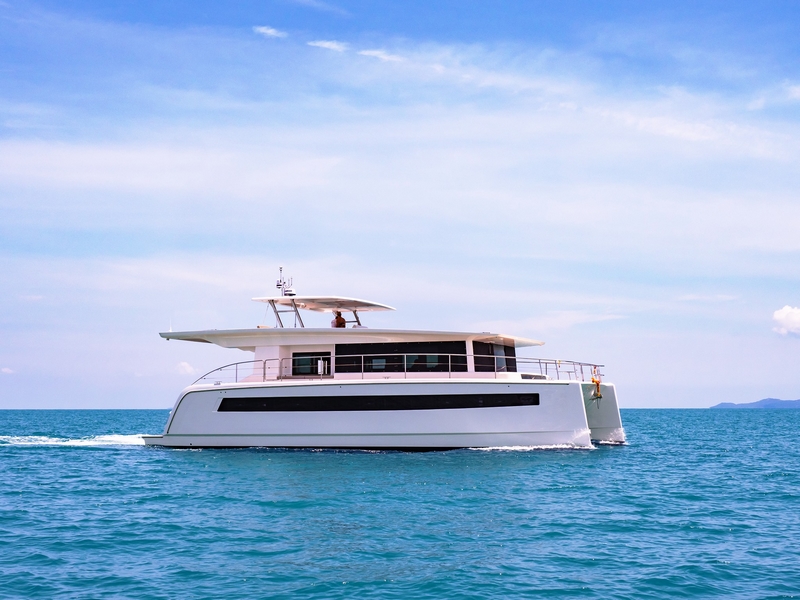
The advantages of the kite wing
There are three major advantages of the kite wing for the yacht. First, extra propulsion. The kite can pull the 30-ton SILENT 60 with about 4-5 knots and it reduces the consumption of the e-motors, thus extending the range. The already green solar electric catamaran gets greener and more eco-conscious this way. Second, emergency. If a floating fishing line gets entangled in the propellers, a kite can serve as a reserve propulsion that enables the boat to get to a protected place where the rope can be cut and the prop set free. Last but not least, fun and joy. It is great to see the kite high up in the air, pulling the boat with the power of the wind.
A new high performance hull form
The SILENT 60 also has a new high-performance hull form that is optimized with CFD study, with longer waterline and reverse bow. Its exterior design’s signature details are long window stripes at the sidewall of the hull and more window surface overall.
“I want to congratulate our entire team with this successful project”, said Michael Köhler. “The SILENT 60 is the first example of a new generation of solar electric catamarans that we produce and many more will follow. We are happy to provide sustainable, emission-free solutions for yachting enthusiasts that want to make the world a better place.”
The owner plans to use his SILENT 60 for a few weeks per year and will make it available for charter.
“I thought it would be a pity to leave the boat unused for the rest of the time, and I have decided to rent the boat on a daily or weekly basis to anybody who is interested in trying out this wonderful yacht for a day trip or for a longer holiday with flexible routings,” he said.
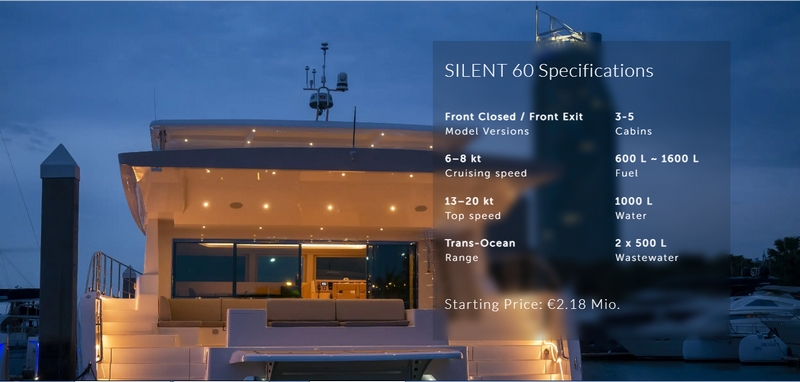
The boat can be handled by two people with ease and offers plenty of space for families and crew.
For adventurers, additional water toys, SUP´s, kayaks and e-bikes can be stored in the bridge deck.
The SILENT 60 offers a flexible layout. The first has four guest cabins on the lower deck, including a spacious master suite. There are many social areas on board, an airy main saloon, an aft cockpit, a cosy bow seating and a flybridge. The yacht has higher headroom everywhere (up to 230 cm in the saloon) and more powerful solar panels (42 pieces for 17 kWp against 30 for 10.8 kWp on the SILENT 55).
The new model has a draft of less than 1 meter, which allows it to reach shallower bays, that may be crucial for areas like the Caribbean and South East Asia. The SILENT 60 has two swimming platforms in the aft which can optionally be extended by 90 cm upon owner’s request. In this case, the boat may carry a pair of electric jet skis. A liftable hydraulic platform, which is located between the two swimming platforms, can also be enlarged from the standard 3.7 x 1.7 m to 4 x 2.4 m to carry a larger tender – up to 350 kg and 4-meter long.
The SILENT 60 is equipped with the company’s aeration system, which provides cool and fresh air to all accommodations, heads, and in the saloon. The airflow in each space is individually adjustable and can be used when the weather conditions require the windows to be closed. In addition, a reverse-cycle heat-pump system heats the interior when necessary, ensuring all-season comfort. The insulated hull ensures efficient achievement of desired on-board temperatures.
The catamaran is designed to go everywhere as a true ocean-going cruising yacht. It can cruise efficiently for up to 100 miles a day for weeks. At the same time, the arrangement of the components enables the system to power all on board systems without.
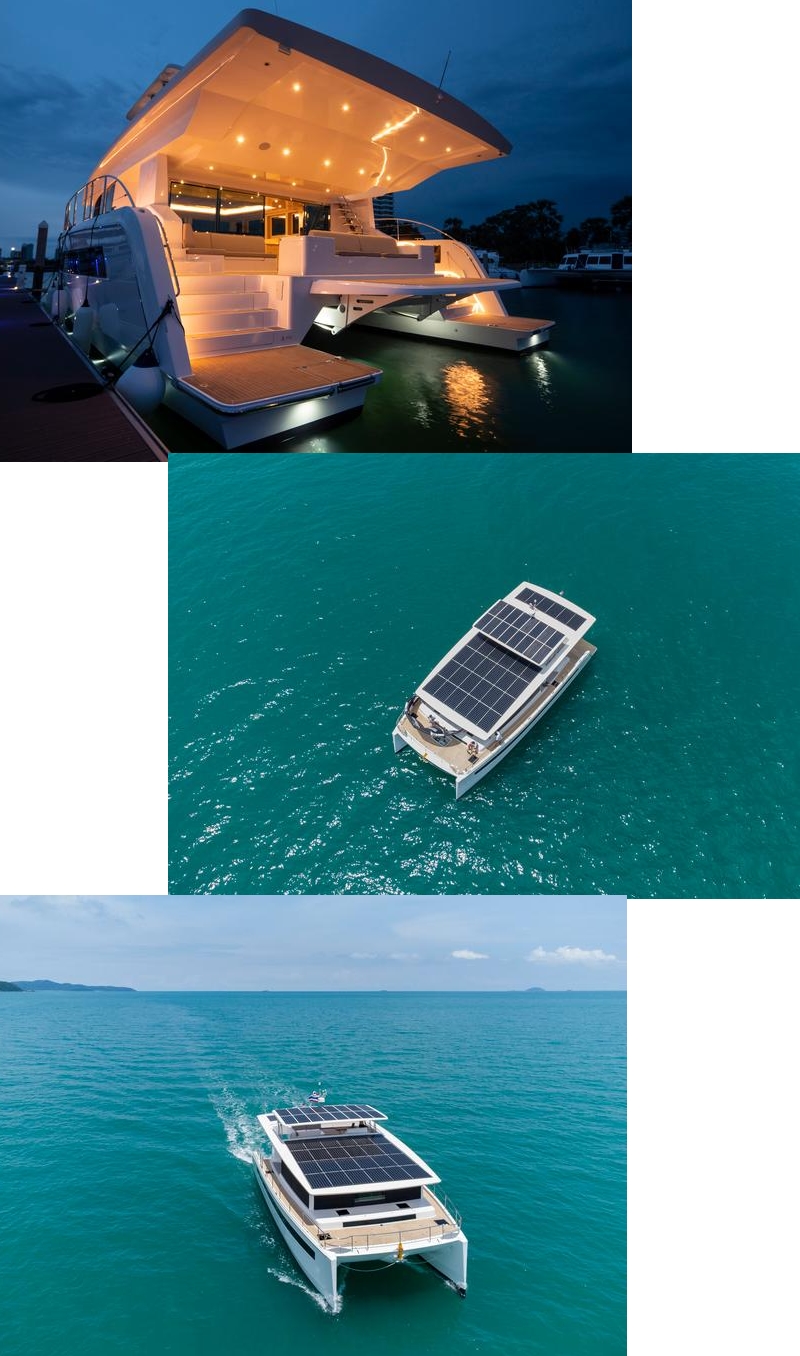

Privacy Overview
- THE PRINCESS PASSPORT
- Email Newsletter
- Yacht Walkthroughs
- Destinations
- Electronics
- Boating Safety
- Ultimate Boating Giveaway

Greener and Better: the Silent 60
- By Chris Caswell
- December 16, 2022
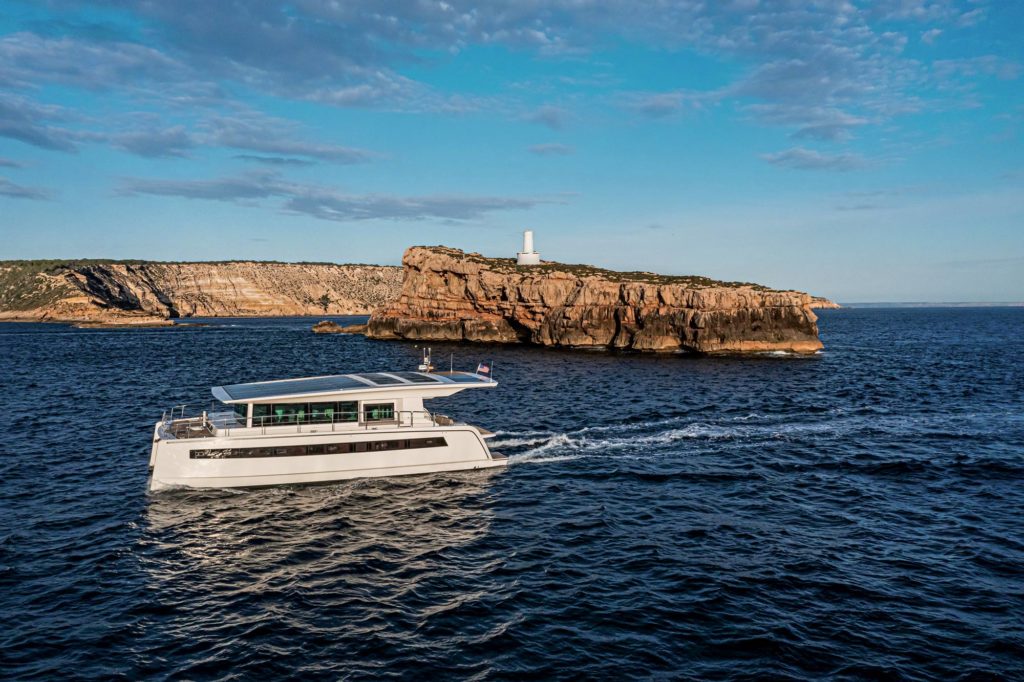
If there was any question that the “Tesla moment” has arrived in yachting, the Silent 60 clearly provides a positive response.
Consider, for a moment, crossing oceans in silence at 5 to 6 knots without consuming a drop of fuel and never needing to plan your course between fuel stops. Imagine sitting at anchor and running the air conditioning all night, not to mention all the galley appliances plus the washer-dryer, without the hum or fumes from a genset.
During my time aboard the Silent-Yachts 60, the electric yacht cruised easily at 8 knots. When I whipped out my sound meter, it barely registered 52 decibels, which is about the sound of a dishwasher. The Silent monitors at the helm showed we were charging our 286 kWh lithium batteries at more wattage than we were using to spin the 340 kW motors, so we were ahead of the power-usage game—and this was in South Florida rain under a solid cloud layer. Had we upped the ante to the yacht’s top speed of 20 knots, it would have been drawing from rather than adding to the batteries, but the speed capability gives skippers the option to outrun weather (or just get to the best moorings first).
The Silent 60 is a catamaran design for several reasons. First, the twin hulls are easily driven to minimize the power needed. Second, with nearly 30 feet of beam, there is enough deck area for the solar panels needed to create power.
Buyers can choose as many as six staterooms, each en suite with stall showers and nearly king-size berths. The salon also uses that beam well, providing bowling-alley space under 7-foot-6-inch headroom. With the Silent 60, the interior is basically a blank sheet, allowing buyers to tailor the layout to their cruising needs.
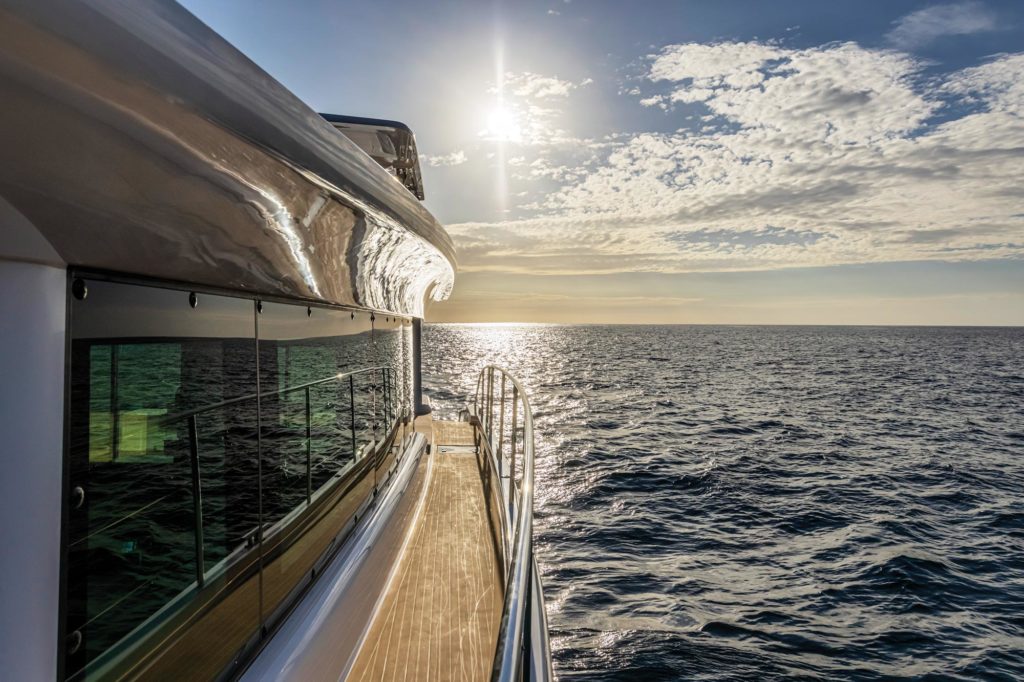
As for the engine rooms, NASA could take a page from Silent-Yachts: Everything is precisely labeled, placed for easy access and surgery-suite spotless. Externally, the Silent 60 is striking, with reversed bows and black graphic slashes on the topside that conceal dark-tinted windows (which provide bright, airy interiors to the staterooms). What catches the eye most, however, are the 42 solar panels that cover every inch of the cabin top as well as the hardtop over the flybridge. Produced by SunPower in California, these panels feed power to a lithium battery pack reportedly good for 3,000 charge cycles—or an estimated 35 years of normal boating use.
The Silent 60 I got aboard, which was Hull No. 3, had a four-stateroom layout. A larger stateroom forward in the starboard hull served as the master, with an athwartships berth, settee and built-in vanity. This yacht also had a walk-through Dutch door forward in the salon next to the helm, leading to settees on the foredeck as well as providing salon ventilation. Another benefit of the door for short-handed cruisers is quick access to the anchor gear under the foredeck.
Owners can sacrifice the forward door in favor of a forward master stateroom with a king berth just a couple of steps below the salon and an en suite head in the starboard hull. An intriguing design feature is the two outward-facing “window seats” indented into the stateroom on each side deck, which would make a wonderful spot at anchor with a good book.
The salon has a fixed dining table that easily seats eight people on the wraparound settee. There also are loose chairs and a pad just forward for lounging. The helm is raised one step and has twin Simrad multifunction displays plus the Silent systems monitor, all easily understood.
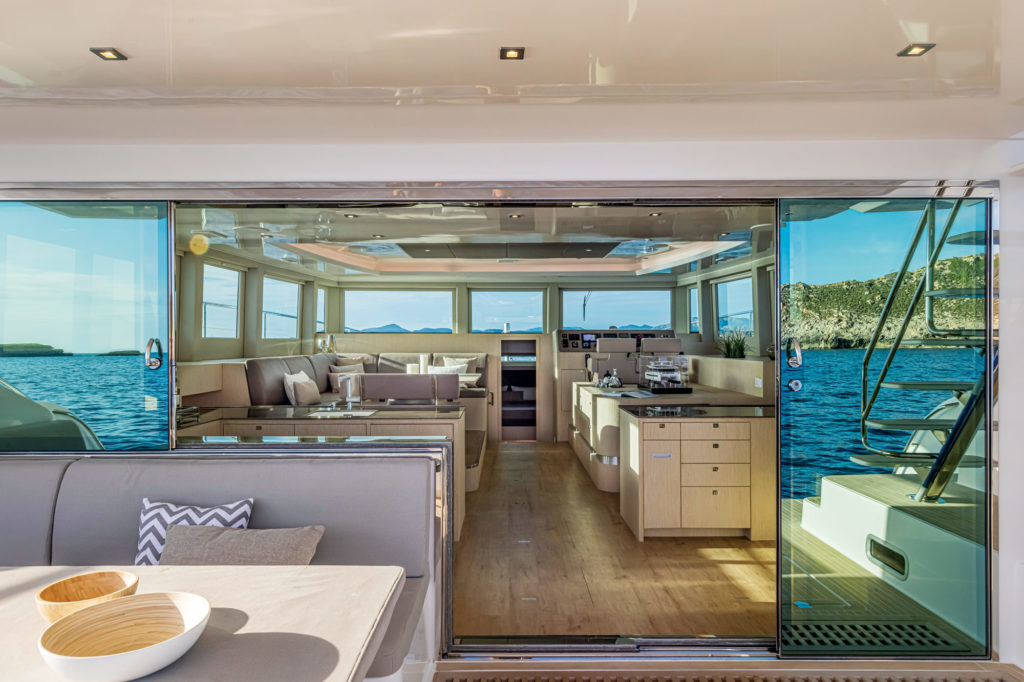
Aft and to port, the U-shaped galley has a dishwasher as well as a full-height fridge to starboard. The fridge setup may change to a pair of undercounter drawer fridges on future boats for easier access and to eliminate a blind spot for the skipper.
Abaft the galley, a window slides open for easy pass-through to the cockpit to serve whatever the cooks have prepared using the Hafele four-burner, two-zone cooktop.
The Silent 60 is a work in progress, and additional changes might be on the way, such as the addition of twin berths that slide together, and a different location for what is now the midsalon washer-dryer (in a console abaft the helm). This hull was built in Thailand, but production is moving to Italy.
Still, the yacht has exceedingly clever design ideas, such as the hinged hardtop on the bridge. The top lowers electrically to seal off the bridge from the weather as well as keep the solar cells from being shadowed. The bridge itself is conventional, with a double-wide helm seat to port that reverses to create wraparound seating for the dining table, and double lounge pads for relaxing, not sunning, since the solar panels take up every bit of sun space.
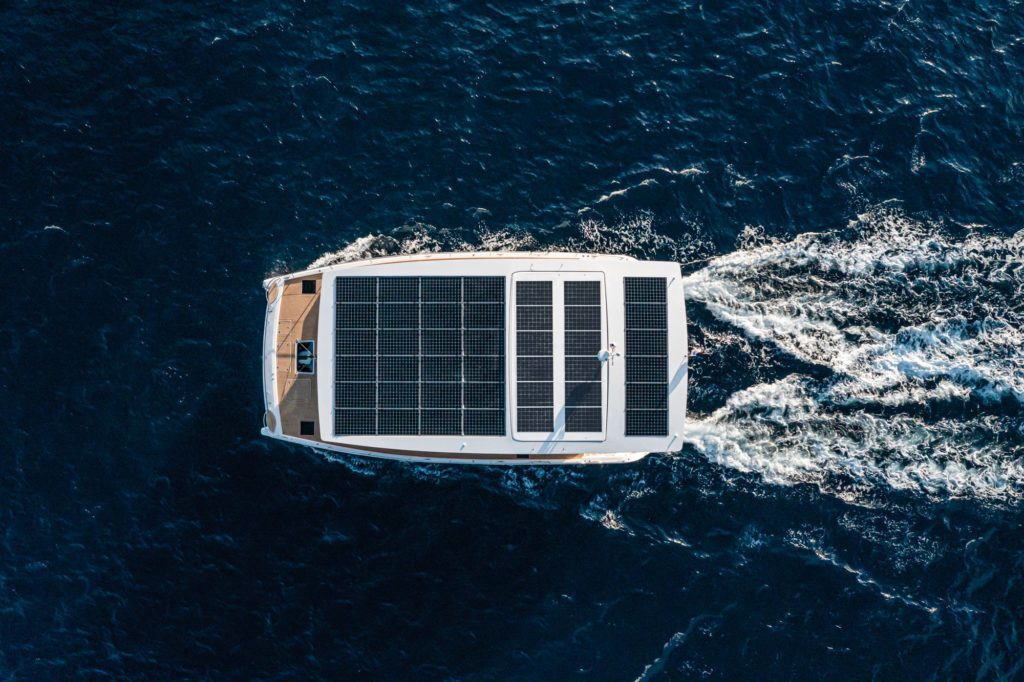
The cockpit has a settee and an L-shaped table. A hydraulic swim platform is available in varying widths to handle up to a 13-foot tender without impinging on the platforms on either hull. Silent-Yachts also gets points for good walk-around decks protected by toe kicks as well as welded stainless-steel rails.
The Silent 60 is on the leading edge of a greener yachting experience. For cruisers who are looking to lessen their carbon footprint while enjoying some quietude at sea, this yacht is worth serious consideration.
Built for Safety
Future Silent 60s from Italy will have fully resin-infused fiberglass sandwich construction with carbon reinforcements in high-stress areas. Each of the hulls has watertight bulkheads, sealed floors and three collision compartments for enhanced safety. The foam sandwich core provides thermal and sound insulation.
Kite Sailing
One option available on the Silent 60 is a kite-wing propulsion system using a collapsing mast and hidden winch to fly a 140-square-foot sail. (By comparison, a Laser sail is 76 square feet.) With open ocean breezes of 17 to 21 knots, the builder says the kite can power the Silent 60 at 6 to 7 knots alone, or it can bump the speed with motors to go faster than the usual 8-knot cruise speed.
Big Sisters
In addition to the Silent-Yachts 60, the boatbuilder has 62-, 80- and 120-foot electric power cats available for owners looking for something bigger. Additionally, it recently started work on the hybrid-powered Silent VisionF 82.
Take the next step: silent-yachts.com
- More: Catamarans , Electric , Electric Boats , October 2022 , Power Catamarans , Reviewed , Silent-Yachts , Solar Powered Yachts , Yachts
- More Yachts
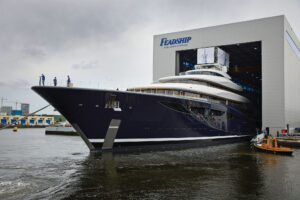
Project 821: The World’s First Hydrogen-Powered Superyacht
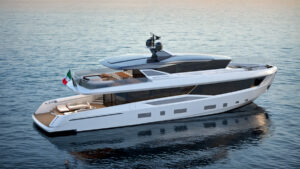
Austin Parker Launches Two New Yacht Series
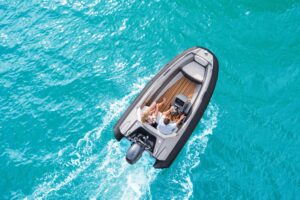
Customize Your Ride: The Argos Nautic GT14 RIB Tender
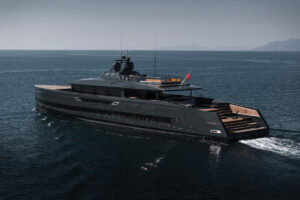
Alia Yachts to Debut SAN Superyacht in Monaco

Octoport’s Carbon-Fiber Yacht Furniture Elevates Life Onboard
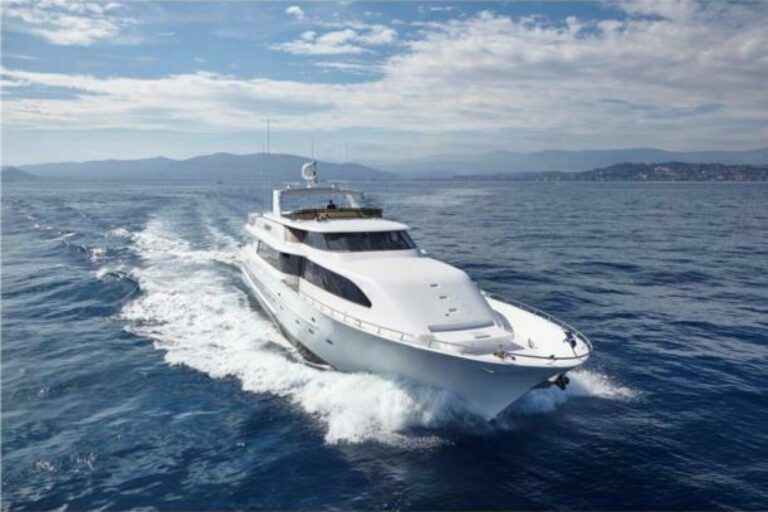
World Traveler: Westport 112 Raised Pilothouse For Sale
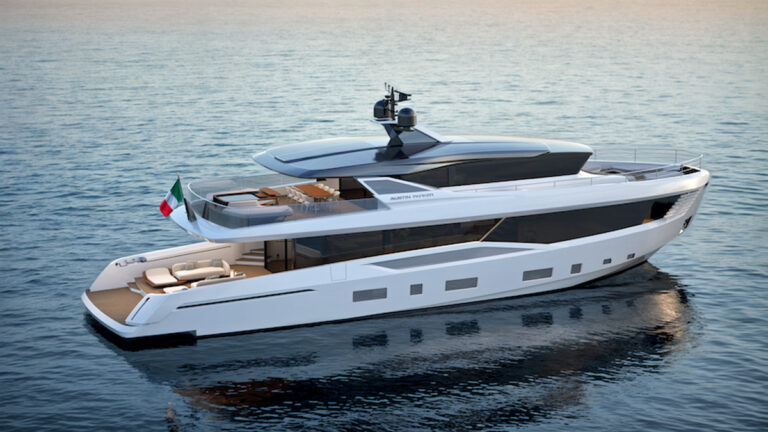
Newport Boat Show Announces New-Product Winners

- Digital Edition
- Customer Service
- Privacy Policy
- Terms of Use
- Email Newsletters
- Cruising World
- Sailing World
- Salt Water Sportsman
- Sport Fishing
- Wakeboarding

Best of Paris 2024
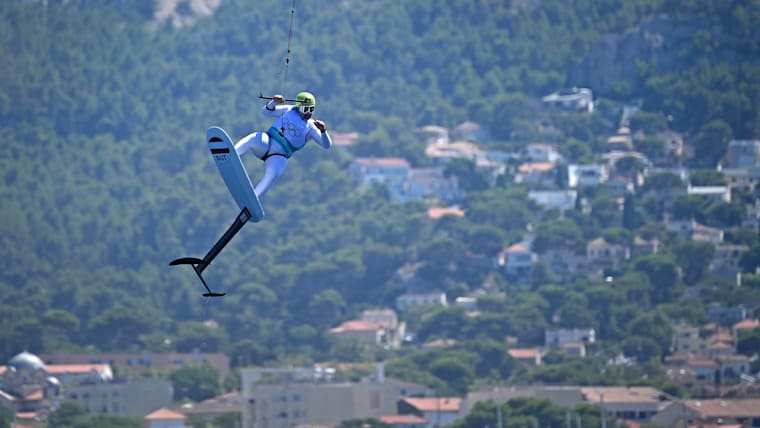
Men's Kite Final | Sailing | Olympic Games Paris 2024
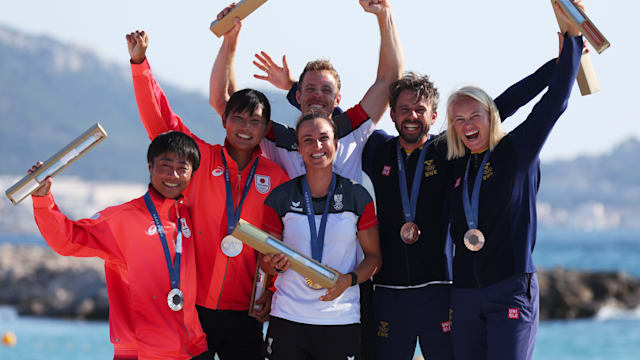
Mixed Dinghy Medal Race | Sailing | Olympic Games Paris 2024

Women's Kite Final | Sailing | Olympic Games Paris 2024

Men's Kite - Medal Series Finals | Sailig | Olympic Games Paris 2024

Men's Dinghy Medal Race | Sailing | Olympic Games Paris 2024
Paris 2024 had it all: Sporting drama, revered venues, singalongs... and Snoop Dogg
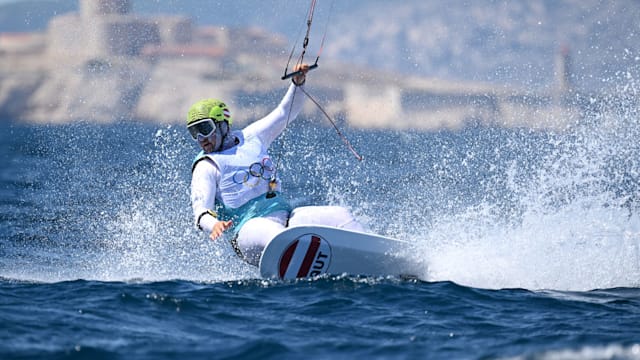
Austria’s Valentin Bontus takes men’s kite gold; first medal for Singapore at Paris 2024

Eleanor Aldridge of Great Britain wins historic first Olympic gold medal in women’s kite

Italy sail to back-to-back Olympic mixed multihull gold

Austria takes mixed dinghy sailing gold
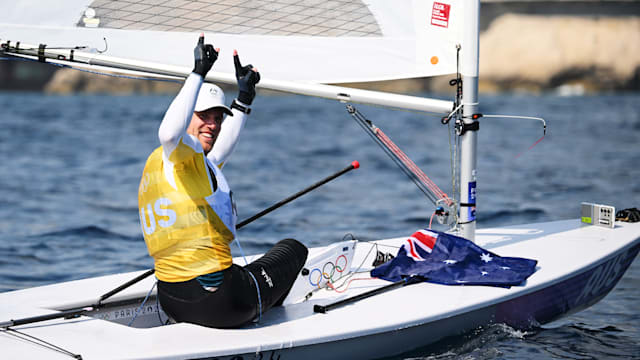
Australia's Matt Wearn wins men's dinghy gold
Sailing - sport explainer presented by allianz, kite sailing, marseille marina.
International sailing races began in 1851 when members of the New York Yacht Club decided to take part in a competition in England. To compete, they built a 101‑foot schooner named America, sailed to England and won a trophy called the Hundred Guineas Cup. The trophy was then renamed The America’s Cup in memory of this first international sailing competition.
Brief overview of the rules
Sailing involves moving a boat solely by harnessing the power of the wind. Mastery over ever‑changing conditions requires both great skill and experience on the part of the athletes. In Olympic events, the rules of the international sailing federation, World Sailing, apply. Competitions are made up of fleet racing, where two equally-matched boats race around the same varied course.
There were ten events at the Tokyo Games, including windsurfing, mixed Nacra 17 Foiling, 49ers and the 470. The various sailing disciplines are constantly changing, and boats are designed to be increasingly small and lightweight, placing ever greater demands on both the athletic and technical capacities of the sailors. Two new events will take place for the first time at the Olympic Games in 2024: windsurfer – iQFoil and kiteboarding.
Olympic history
Sailing has featured on the programme at every edition of the Olympic Games of the modern era. They could not take place on 1 st April 1896 in Athens, however, as bad weather conditions forced the organisers to cancel the events. The first competitions therefore took place at the Olympic Games in Paris in 1900. Since then, the categories included in the competition have constantly evolved. The different events are organised by monotype classes—i.e. their size and weight.
IN ASSOCIATION WITH
The pictogram, worldwide partners.


Here you can find the answers to all of the most frequently asked questions about Silent Yachts. If you have additional questions, our team will be happy to advise you.
01. What is the price of a Silent yacht?
For more information about the prices of our Silent yacht models, please get in touch here: Contact
02. Can a Silent yacht cross the Atlantic?
All our yachts are CE-A certified, which means that they are suitable for ocean crossings. In 2018, the Silent 64 set a world record as the first serial production solar powered electric yacht to cross the Atlantic Ocean.
03. Are electrical yachts practical?
Yes. As the propulsion system of an electrical yacht has fewer components and is much smaller than a conventional drivetrain, there is an additional amount of space on board which can be used for a variety of purposes.
04. Are electric yachts quiet?
Silent yachts are quiet, as the electric motors are noiseless. However, some manufacturers make use gearboxes which could be relatively noisy.
05. Are electric yachts cheaper?
While the purchasing price of electric yachts is similar to the price of conventionally powered yachts, the ownership costs are far lower. This is a result of lower maintenance due to the lack of moving parts of a normal engine, less repairs bills and minimal to no expenses for fuel.
06. Can you buy a Silent yacht?
Yes, Silent Yachts offers full serial production solar powered electric yachts ranging from 60 to 120 feet.
07. Is there any electric yacht?
Silent Yachts are the first ocean-going electric production yachts in the world, which are powered by solar energy. Storing the energy of the sun in state of the art battery banks enables guests on board to be fully solar sustainable while having the possibility of unlimited range with zero emission.
08. Do you offer sustainable materials on board?
Yes, we do. You have a choice to choose between premium sustainable materials such as bamboo, flax fibre, basalt fibre and cork. They help shape a unique yachting experience while significantly reducing the overall footprint on the environment. For more details, please visit our dedicated sustainability chapter.
09. What is the meaning of the number in each of the Silent Yachts model names?
The number of each model (Silent 60, Silent 62, Silent 80, Silent 120) indicates the overall length of the yacht in feet.
10. Which boating licence do I need?
Silent yachts require the same motorboat license as any other boat of the same length in the same operational area. No specific license required.
11. What about the CE-A Certification? What does it mean for the buyer?
All boats available on the market are classified according to four different CE categories.
Category A – Ocean: This is the certification level with the toughest standards and covers vessels of 40’ and over which are designed to be self-sufficient for extended voyages. It is defined as the “category of boats considered suitable for seas with significant wave heights of up to 23 feet (7 meters) and winds of Beaufort force 9 (41-47 knots) or less, but excluding abnormal conditions such as hurricanes.”
Category B – Offshore: Boats operating offshore with winds to 40 knots and significant seas to 13 feet.
Category C – Inshore: Boats operating in coastal waters and large bays and lakes with winds to force 6, up to 27 knots, and significant seas 7 feet high.
Category D – Inland or sheltered coastal waters: boats in small lakes and rivers with winds to force 4 and significant wave heights to 18 inches.
All our yachts are CE-A certified, which is the highest level of certification obtainable in Europe. As a result, all Silent Yachts are true ocean cruisers designed to circumnavigate the world.
12. What are advanced sea trials?
The goal of advanced sea trials is to experience solar powered yachting first-hand and receive a personal introduction to understand the technology and its benefits in order to be able to make an informed purchase decision.
If you would like to come on board and do an advanced sea trial, please get in touch here: Contact
13. How much does it cost to operate a solar powered yacht?
The operational costs of a solar powered yacht are far lower in comparison to regular diesel-powered motor yachts. The main reason here fore is the fact that an electric motor only has one moving part in comparison to the hundreds of moving components of an internal combustion engine. Virtually no maintenance means virtually no maintenance costs. Secondly, refueling the conventional yacht with diesel makes up for a significant proportion of the operational costs. Recharging a Silent with the help of the sun however is free.
14. Are there different cabin configurations for each Silent yacht model?
Yes, every model in our range offers a variety of different cabin configurations to suit different needs. On our website you can find the standard cabin configuration of each model. If you would like to take a look at further cabin configurations, please get in touch with our team and they will provide you with the respective model brochures which showcase all options.
15. What are the main advantages of a solar powered Silent yacht?
In terms of the actual yachting experience, Silent yachts offer virtually unlimited range with zero emission. Furthermore, noiseless cruising makes sure you will have relaxing time on board.
The solar-electric drivetrain is not only the safest and most reliable marine propulsion system, in comparison to regular internal combustion engines there is virtually no maintenance required as well.
From an operations point of view, there are 8 years of warranty on the battery banks, 40 years on the solar panels and life-time warranty on the electric motors. Every Silent yacht is CE-A certified and therefore offers full trans-ocean crossing capabilities.
For more information, check out “Why Solar Power?” and “Why Silent Technology?”
16. What is the difference between a solar powered electric Silent yacht and a conventional powered yacht?
Conventional motor yachts are powered by diesel- or gas-engines. Additionally, they have one or even two generators on board to supply all household appliances. Hence, depending on the size of the yacht, a total number of 3 or 4 diesel engines are used to provide propulsion and feed the household devices with energy.
Sailing yachts need a diesel-engine too. Depending on the operational area as well as the wind- and weather-conditions, a diesel engine is required in addition to the sails for the propulsion of the boat. When anchoring in a quiet bay, the diesel generators ensure the energy-supply of the household appliances on board. In fact sailing vessels have a very similar engine setup as a motor yacht, just less powerful, therefore a sailing catamaran of 80 feed has always 2 diesel engines for the propulsion and 2 diesel generators. Compared to that an electric Silent yacht requires only one diesel generator, which reduces the required maintenance and the costs significantly.
As most yachts use gas for cooking, the open flame not only heats up the interior but also causes an imminent threat. Furthermore, on many yachts the consumables like water and energy are managed in a way that enforces the skipper to visit a marina every two or three days to charge the batteries and to buy water for showering and drinking. In contrast to that a Silent yacht is autonomous and self-sufficient. Therefore there is need to go to a marina on a regular basis, as a Silent produces the energy and the water it needs on its own with solar energy.
Lastly, a conventionally powered boat has a range of 300 to 500 nautical miles before needing to refill the diesel engine. The use of a combustion-engine is, of course, inevitably also combined with noise, exhausts and oily films in the water.
In comparison, a Silent yacht can cross oceans and stay in a bay for months by storing the energy generated through the solar panels in large capacity batteries. This electrical energy is used for propulsion and well as powering all household appliances on board. All this happens completely noiseless, without vibrations and pollution while also offering the possibility of having virtually unlimited range.
01. How big of an electric motor do I need for my solar powered yacht?
The smallest electric motors fitted to a Silent yacht are two 50 kW motors on the cruiser configuration of the Silent 60 series.
02. How do electric yachts get fresh water?
All Silent Yachts are equipped with a water maker, which processes sea water into fresh water.
03. Can you power a yacht with an electric motor?
All Silent Yachts are powered by electric motors. The instantly available torque ensures a smooth drive at any time. More information on our electric propulsion system can be found on our technology page .
04. How long does an electric yacht motor last?
As electric motors only have one moving part, they are very reliable in comparison to regular internal combustion engines, which have a larger number of moving parts. Therefore, at Silent Yachts we offer a lifetime warranty on all electric motors installed in our yachts.
05. What motors do Silent yachts use?
Silent yachts engineers design and configurate our proprietary in-house drivetrains. We only integrate components from leading producers in their respective industries. For more information about the solar-electric drivetrain , please visit “Why Silent Technology” .
06. Do electric yachts have generators?
All Silent yachts are equipped with back-up range extenders, which can recharge the battery banks whenever needed. More information can be found on our “Why Solar Power?” page.
07. How efficient are electric yachts?
As Silent yachts were created to be fully electric from the ground-up, they are highly efficient. Every aspect of our yachts, from the design of the hull to the interior and its appliances is designed to minimize energy consumption and maximize efficiency. This enables sustainable self-propulsion with virtually unlimited range. More information can be found here “Why Silent Technology?” .
08. Where do our yachts get electricity from?
The main source of energy of our yachts is the sun. In a typical holiday region during the typical holiday season on an average sunny day the solar panels produce enough energy to power the propulsion system as well as all household and navigational appliances on board for regular holiday use. To learn more about the solar technology powering our yachts, please visit our dedicated chapter here “Why Solar Power?” .
09. How fast can a Silent yacht go?
The cruising speed is usually around 6 – 8 kn.
10. Why are there no wind generators?
During the testing phase of the Solarwave 46 Prototype, Michael & Heike gathered extensive experiences with the usage of wind generators as well. The energy they generate does not compensate for the energy loss they produce by throwing shade on the panels. When turning at high speeds, wind generators are also very noisy and do not create a Silent cruising experience. Depending on their placement, they are also quite dangerous, potentially creating serious safety hazards.
It is not surprising that not even sailors on sailing boats choose the windiest regions of this planet for their holiday. They prefer to stay in a calm a protected bay for swimming and even more to stay over-night. Calm and protected means no wind and therefore no energy coming from the wind generator. However, the shade created by the wind generators would affect the solar panels on every sunny day and as a result reduce the daily production.
11. Can the generator charge depleted batteries and power the ship including all the appliances on board while the boat is underway?
Yes. The generator can recharge the battery whenever necessary. However, it is generally not required to start the generator for the operation of any of the household appliances on board. It is also not required to start the generator for higher cruising speeds. It merely functions as a back-up in case you travel longer distances at high cruising speeds.
12. What about adding a regular sail or kite sail?
As regular sails would throw a lot of shade on the panels, which would lead to a significant decrease in energy, all our models are available with an optional kite sail system instead.
In comparison to a regular sail, the fully automatic towing kite has several advantages:
• No shade created on the panels • Up to 10x more towing power created per m2 • Less maintenance required • Lower maintenance costs
For all sailors who would love to make use of the wind as well, the kite sail system perfectly complements the trademark Silent Yachts solar electric drivetrain as an effective addition.
13. Is there a video showcasing the energy generation & consumption of your electric yachts in realistic scenarios?
Yes, you can check out our Silent 80 energy generation & consumption video here .
The storyline takes you along on a trip of two days in order to showcase a variety of realistic scenarios, based on the Silent 80 E-Power + version. It will show you exactly how different situations affect the production and overall energy management with the help of the solar panels, electric motors and lithium battery banks on board.
14. Which propulsion system do Silent yachts offer?
All our models are powered by our unique solar electric drivetrain. It consists of market leading solar panels, powerful electric motors, state-of-the-art lithium batteries and an efficient back-up generator. This system produces enough power in order to supply energy for propulsion as well as all onboard appliances. For more details, please visit “Why Solar Power?” .
15. How many kW do the solar panels generate?
The amount of power generated by the solar panels in total depends on the specific model. Here are the individual peak power figures and the daily production of each Silent yacht:
Silent 60 & Silent 62 3-Deck
- 16 kWp – about 100 kWh per day
Silent 80 & Silent 80 3-Deck
- 26 kWp – about 150 kWh per day
- 40 kWp – about 240 kWh per day
Important to note – the kWp does not tell you anything about the daily production. When the panels are mounted in an unfavourable angle to the sun – for instance on the sides of the hulls – they are shaded for most of the time of the day. Same applies if they are mounted on a roof with a mast and a boom placed on top of it. Or if they are configured in smaller areas of different size and different angle to the sun. In all these cases their production will be close to zero. It is not surprising that yachts of same size having panels on the hull sides harvest only a third of the energy which you get on a Silent.
The design of our solar roof and our arrangement of the panels are the secrets of the “Silent Autonomy”, which makes our Silent yachts so unique.
16. Which company builds the electric propulsion system?
The electric propulsion system is built in-house by using highest quality industrial grade products. Our specific configuration of every individual component makes the resulting system unique.
01. Can Silent Yachts be used for commercial use such as passenger ferries?
While commercial uses are not part of our regular model range, we have already customized our solar powered yachts for such situations in the past. The Silent 55 has been built as a passenger ferry. Therefore, we would kindly ask you to get in touch with us in order to evaluate potential commercial usage regarding your specific needs.

COMMENTS
Performance data in the description. As the first luxury yacht manufacturer, we are now combining the power of the sun as well as the wind to provide an even...
Kite sail system premiere video - Silent Yachts® OFFICIAL. The first video of our SLENT 60 equipped with the kite sail system is now online! When testing the 9m² kite at wind angles of up to 40 degrees, with the engines turned off and no propellers turning, the SILENT 60 effortlessly reached speeds between 4 and 5 knots.
Silent-Yachts has showcased its first Silent 60, which carries 42 solar panels for 17kWp of solar energy and is further boosted by the brand's optional kite sail system. Succeeding the 64 and 55 models, the Silent 60 is the first of the builder's new generation of yachts that also include the 62 3-Deck, 80, 80 3-Deck and 100, with each 3 ...
Silent Yachts shared the SILENT-60, a catamaran with 42 solar panels and two electric motors backed by 286 kWh of battery capacity.
The 130-sq. foot Wingit kite allows for zero-emission yachting, and generates 10 times more power per square foot than a conventional sail.
Silent 60, The Solar Electric Catamaran With a Kite Sail System. The new SILENT 60 solar powered catamaran carries 42 solar panels for 17 kWp of solar energy to power two electric motors of up to 2x340kw. Backed up by a battery capacity of up to 286 kWh, the yacht can cruise efficiently with zero emissions solely on solar power for up to 100 ...
The solar-powered Silent 60 catamaran features a kite that increases speed by 5 knots to enable the vessel to reach 20 knots at full tilt.
The Silent 60 catamaran is powered by 42 solar panels. Silent Yachts. In full flight, the kite has a surface area of 13 sq m (139 sq ft) and is said to generate up to 10 times more power per ...
the kite wing on the new SILENT 60 yacht generates up to 10 times more power per square meter than a traditional sail.
Silent-Yachts offers the optional available kite-sail system for all their models. "The kite system sounds like the perfect match for windy days together with the electric propulsion system of Silent-Yachts," said the German owner of the first Silent 60.
As the successor to the Silent 64 (the first ever solar powered production yacht to cross the Atlantic Ocean during January of 2018), the 60 Series is equipped with the most refined, efficient and clever technology available today. Being a multi-award winner, including the prestigious "Best of Boats Award" in the category of 'Best for Travel', she embodies solar electric yachting in ...
On the smaller 55 and the 64, Silent Yachts currently recommends a 19m2 kite that costs around €25,000 - a fraction of the cost of a new mast, boom, shrouds and sails. "The sail ...
As such, the SILENT 120 Explorer is more than a yacht - she is the boldest expression of solar powered yachting yet. ... Kite sail system premiere video. 12.11.21. Silent 60 wins "Best of Boats" award. 03.11.21. NautiStyles Silent60 video tour. 07.10.21. Silent Yachts x Porsche.
Photo: Silent Yachts/Alberto Cocchi After introducing the first oceangoing production yachts in the world fully powered by solar energy in 2018, Austrian builder Silent-Yachts has added a kite sail system that can add up to 5 knots of speed.
After presenting the first ocean-going production yachts in the world that are fully sustainable and powered by solar energy, Silent-Yachts now is the first boat builder to date to design and build boats for the use of a kite sail system.The new Silent 60 solar powered catamaran carries 42 solar...
Silent Yachts offers the optional available kite-sail system for all their models. "The kite system sounds like the perfect match for windy days together with the electric propulsion system of Silent Yachts," said the German owner of the first SILENT 60.
The Silent-Yachts Silent 60 is an environmentally friendly, bluewater catamaran with 42 solar panels and four staterooms.
SILENT YACHTS is bringing a revolutionary silent cruising system that combines wind and solar power to create an even more eco-friendly cruising experience. ...
Solar yachts by Silent Yachts are the first ocean-going production yachts in the world which are powered by solar energy. Electric yachts.
Key features of luxury superyacht Silentworld. Silentworld had a lot to recommend herself. Five luxurious cabins - including a master suite with a generous bathtub, waterfall shower and a private study - can accommodate up to 10 guests on board. Her walnut-finished interiors offer a main saloon with a living room and a formal indoor dining space, as well as a skylounge which transforms ...
Kite Sailing. Venues. Sailing. Marseille Marina. International sailing races began in 1851 when members of the New York Yacht Club decided to take part in a competition in England. To compete, they built a 101‑foot schooner named America, sailed to England and won a trophy called the Hundred Guineas Cup. The trophy was then renamed The ...
For all sailors who would love to make use of the wind as well, the kite sail system perfectly complements the trademark Silent Yachts solar electric drivetrain as an effective addition.